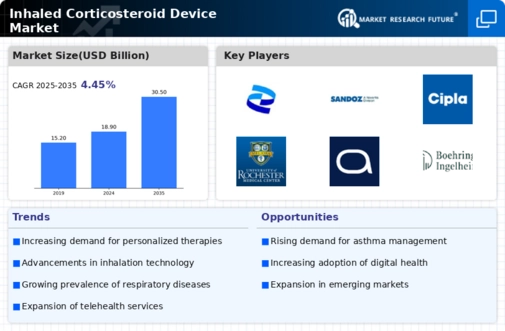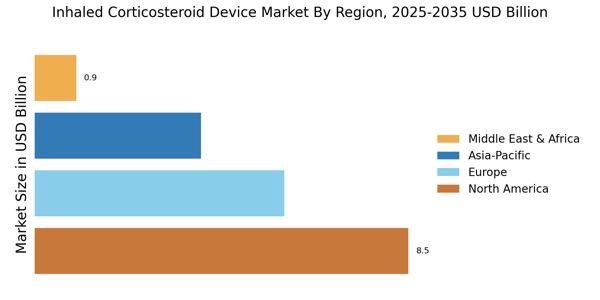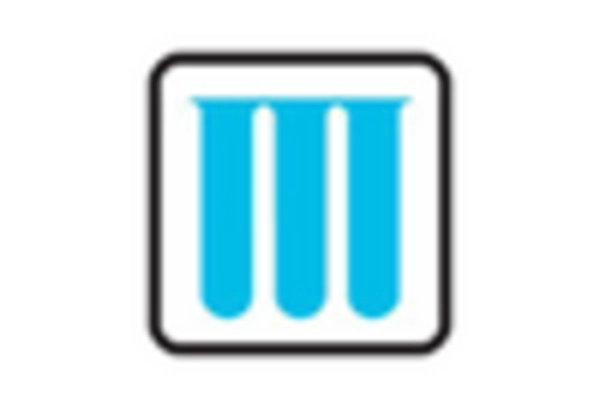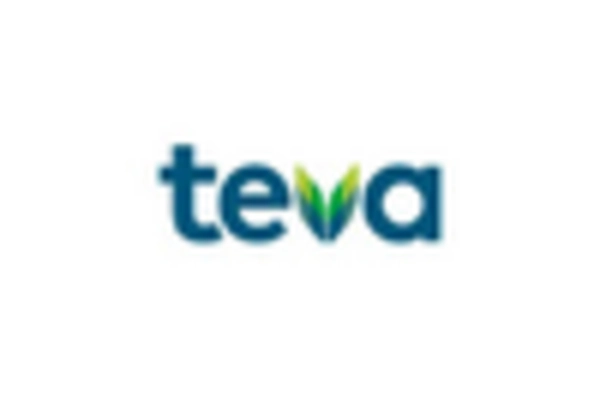Increasing Healthcare Expenditure
The rise in healthcare expenditure across various regions is a notable driver for the Inhaled Corticosteroid Device Market. As countries allocate more resources to healthcare, there is a corresponding increase in the availability and accessibility of advanced medical devices. This trend is particularly evident in developed economies, where healthcare budgets are expanding to accommodate innovative treatments for chronic diseases. The World Health Organization indicates that healthcare spending is projected to grow by 5% annually, which may lead to greater investment in inhaled corticosteroid devices. Consequently, this influx of funding could facilitate the development and distribution of these devices, ultimately benefiting patients and healthcare systems alike.
Rising Prevalence of Respiratory Diseases
The increasing incidence of respiratory diseases such as asthma and chronic obstructive pulmonary disease (COPD) is a primary driver for the Inhaled Corticosteroid Device Market. According to recent data, asthma affects approximately 300 million individuals worldwide, while COPD impacts around 250 million. This growing patient population necessitates effective management strategies, leading to heightened demand for inhaled corticosteroid devices. As healthcare providers emphasize the importance of adherence to treatment regimens, the market for these devices is likely to expand. Furthermore, the rising awareness of respiratory health and the need for preventive care may contribute to the growth of the Inhaled Corticosteroid Device Market, as patients seek reliable solutions for managing their conditions.
Growing Awareness of Preventive Healthcare
The rising awareness of preventive healthcare is driving the Inhaled Corticosteroid Device Market. As individuals become more informed about the importance of managing respiratory conditions proactively, there is an increasing demand for effective treatment options. Educational campaigns and public health initiatives are playing a crucial role in promoting awareness about asthma and COPD management. This heightened focus on prevention is likely to lead to greater adoption of inhaled corticosteroid devices, as patients seek to mitigate the risks associated with their conditions. Furthermore, healthcare providers are increasingly advocating for preventive measures, which may further stimulate the growth of the Inhaled Corticosteroid Device Market.
Technological Innovations in Device Design
Technological advancements in inhaled corticosteroid devices are significantly influencing the Inhaled Corticosteroid Device Market. Innovations such as smart inhalers, which provide real-time feedback and adherence tracking, are becoming increasingly prevalent. These devices not only enhance patient engagement but also improve treatment outcomes. The integration of digital health technologies is expected to drive market growth, as patients and healthcare providers alike recognize the benefits of data-driven management. Additionally, the development of more efficient aerosol delivery systems is likely to enhance drug deposition in the lungs, further propelling the demand for inhaled corticosteroid devices. As these technologies continue to evolve, they may reshape the landscape of the Inhaled Corticosteroid Device Market.
Regulatory Support for Innovative Therapies
Regulatory bodies are increasingly supporting the development of innovative therapies, which is positively impacting the Inhaled Corticosteroid Device Market. Streamlined approval processes and incentives for research and development are encouraging manufacturers to invest in new inhaled corticosteroid devices. This regulatory environment fosters innovation, allowing for the introduction of advanced products that meet the evolving needs of patients. As a result, the market is likely to witness a surge in new entrants and product offerings, enhancing competition and driving growth. The proactive stance of regulatory agencies may also lead to improved patient access to these essential devices, further contributing to the expansion of the Inhaled Corticosteroid Device Market.


















Leave a Comment